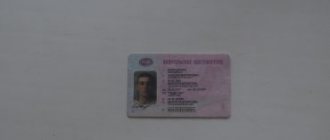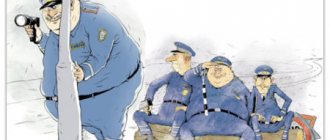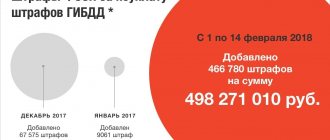Reasons for filing an appeal against the traffic police decision?
The need to appeal a traffic police decision may be due to the following reasons:
- technical error of the camera during video shooting;
- the desire to fundamentally defend one’s own innocence before representatives of the traffic police;
- another person was driving a car at the time the offense was recorded - the car was being driven by a relative or acquaintance;
- sale of a car and untimely re-registration to the new owner, so messages about penalties are sent to the old address;
- the presence of mitigating circumstances that reduce the amount of the fine imposed, and others.
Attention
It is permissible to file a petition not only for incorrect actions of a representative of an authority, but also for inaction that caused unfair punishment.
To protect yourself, in the event of an inspection by a traffic police representative, when drawing up a resolution and protocol, you must adhere to the following recommendations:
- check the contents of the documents in detail for errors;
- if inconsistencies are identified and the government representative refuses to take them into account in the document, reflect personal opinion when signing the paper;
- it should be persuaded to include in the document the presence of an eyewitness testifying in favor of the accused of an offense;
- will help prove the correctness of video and photo materials taken at the scene of the incident or filmed by the registrar;
- if there are empty lines in the readings, they should be crossed out to eliminate the possibility of unwanted filling;
- You should receive a copy of the document, which will help you take care of your own protection in a timely manner.
IMPORTANT
It is necessary to understand the difference between the resolution and the traffic police protocol. The first document records the fact of the violation, confirms the guilt of the violator and establishes the amount of the fine. In the second (when drawing up a protocol), the circumstances of the incident are set out without drawing conclusions about its causes and those responsible.
https://www.youtube.com/watch?v=ytpolicyandsafetyru
The choice of the authority where you need to file an application to appeal the decision of the traffic police depends on who made the decision to bring to administrative responsibility:
- if this is a court, the complaint is sent to the appropriate higher authority;
- collegial authorities - similar regional structures;
- officials - their leaders within a given region;
- other structures - to the district courts of the subject where the case was heard.
Art. 28.3 of the Code of Administrative Offenses determines the need to appeal court decisions only to higher authorities of the specified branch of government.
In some situations, it is possible to submit a petition to the traffic police; this will be discussed below.
It is necessary to file a complaint with the judicial authorities if we are talking about serious violations of the traffic police related to the following circumstances:
- causing damage to the health of other people as a result of a driver’s mistake;
- repeatedly crossing a double continuous marking line or exceeding speed limits by more than sixty kilometers per hour;
- driving while intoxicated of various types;
- driving a car without a driver's license.
Please note:
If the consideration of the issue is related to controversial issues, is associated with procedural violations or incorrect interpretation of legislative acts, it is necessary to contact the judicial authorities.
From the meaning of Art. 30.1 of the Code of Administrative Offences, it follows that for one complaint only a single decision on bringing to administrative responsibility can be considered. Filing a complaint simultaneously against two decisions of the traffic police in one application is unacceptable according to the norms of the Code of Civil Procedure of the Russian Federation.
The design rules are simple. They are specified in articles 131-132 of the Code of Civil Procedure of the Russian Federation.
The complaint must be drawn up on an A4 sheet, written by hand or printed on a PC.
Documents are attached to the complaint.
In what cases is it realistic to challenge fines from traffic police video recordings, and what happens if this fine is simply not paid?
1. Document header
In it, on the right side of the sheet, indicate the name of the traffic police authority to which you are filing a complaint, as well as the name of the chief. It is worth finding out this information in the department.
Next, enter your details – full name, residential address and contact information.
Most often they indicate a telephone number for contact.
2. Name of the document
In our case, in the middle of the line with a capital letter we write “Complaint against a decision in a case of an administrative offense.”
Don't put a period at the end of a sentence!
https://www.youtube.com/watch?v=ytadvertiseru
3. Content part
In it, describe what circumstances prompted you to contact the traffic police department, why you do not agree with the decision/resolution.
Be sure to indicate on what grounds the decision was made illegally and unlawfully.
- Unreasonableness of the decision made.
- Unproven violation.
- The unreality of circumstances and situations.
- Incorrect interpretation of the law.
- Leaving a previously submitted application without consideration.
Of course, you should not file a complaint several times. It is enough to contact the immediate head of the traffic police department.
4. Final part
Describe your demands - to cancel the resolution, to stop proceedings on this issue. Next, describe with a list what documents you are attaching, and sign and date.
How and to whom is it correct to complain about the actions or inactions of a traffic police officer?
When writing a complaint to the court, you must take into account some points. A complaint is written more formally than an appeal to the traffic police.
- Name of the court, address of the instance.
- Details of the person who applies to the court – full name, address, contact information.
- Third party interested in the case, his name, address. This may be the traffic police department to which the plaintiff previously filed a complaint, or the official who issued the decision.
- The number of the decision that came in the letter. Issue date. Brief content of the resolution.
- Grounds, reasons why this resolution should be canceled. We wrote about the content and arguments in the last section of the article. You can find out what grounds you can rely on when writing an application. It is better to refer to application documents that will confirm your guesses.
- Possible actions of the applicant aimed at pre-trial consideration of the issue.
- Request to cancel the decision/ruling, other requirements.
- List of documents.
- Date of application.
- Applicant's signature.
The owner of the car, or a legal representative, or a lawyer can file a complaint with the court.
Don't forget to include a power of attorney if a representative applies.
Remember: the more detailed the situation is described in the content, and the more accurately the evidentiary materials are selected, the greater the chances of a successful consideration of the case.
All complaints to the traffic police that refer to the technical imperfections of video recording cameras are empty and hopeless. Unfortunately, statistics tell us this.
Of course, perhaps in your case there really was a blatant injustice, then simply state the essence of your disagreement in a complaint, a sample of which you can find everywhere, and provide your evidence to the court or the traffic police.
But if you want to “excuse” yourself from a traffic police fine, then they are not idiots there either, they understand this very well.
We suggest you read: Hiring liability for violation
My method has been tested many times, but it is not ideal, since it can be applied if someone other than the owner of the car is included in the compulsory motor liability insurance policy or the insurance is unlimited. Therefore, it is not suitable for everyone, but if this is the case with your insurance, then you are lucky.
And so, if you have an MTPL policy for only one car owner, then this instruction will only work next time - add someone else or make it unlimited.
And you will have in your pocket the secret of how to challenge a fine from a traffic police camera. Although, as you know, you should not abuse it, sometimes such opportunities come in very handy. It's like Superman who has some kind of unusual ability.
Next, go to the post office and send your complaint by registered mail, with acknowledgment of delivery, allowing you to track delivery. That's all. You are awaiting consideration of your complaint.
If you did everything correctly, then law enforcement officials will be required to cancel the order.
You will also receive the decision to cancel the decision by email. That is, all you have to do is wait.
That's all for me. I would like to wish you success and more canceled decisions.
Another popular fine from traffic police cameras that makes sense to appeal is a fine for someone else’s car. Often the traffic police camera makes mistakes and confuses license plates that are similar in appearance. Such fines are usually appealed without problems.
A sample complaint will help you appeal a traffic police fine from a camera.
Example of a complaint
To the head of the State Traffic Safety Inspectorate of the Ministry of Internal Affairs for […] region/city of Ivanov, Ivan Ivanovich Petrova I.I., residing at […]
COMPLAINT against a decision in a case of an administrative offense
On July 1, 2021, I received a resolution in the case of an administrative violation recorded by a video recording complex, according to which I am held accountable in the form of a fine of 1000 rubles in accordance with Part 1 of Art. 12.12 Code of Administrative Offenses for driving through a prohibiting traffic light signal. I consider the imposition of this penalty on me to be unlawful for the reasons stated below.
On June 16, 2021, at the intersection of Lenin Street and Griboyedov Street, traffic control was carried out by a traffic police officer (traffic controller). According to clause 6.15 of the Traffic Regulations of the Russian Federation, the driver is obliged to comply with the requirements and signals of the traffic controller, even if they contradict the traffic light signals. I passed the intersection at the prohibitory traffic light signal in the forward direction, but at that moment the traffic controller was positioned on my left side with his arms outstretched - according to clause 6.10 of the Russian Traffic Regulations, this signal allows passage of the intersection in the forward direction.
Based on the aforesaid and guided by Article. Art. 30.1, 30.2, 30.3 of the Code of Administrative Offenses of the Russian Federation, I ask you to cancel the decision on an administrative violation (details of the decision: by whom, when issued, number).
I am attaching to this complaint a copy of the resolution, as well as a link to a video recording from a complex of video recordings of violations (you can also attach other documents, petitions, photographs, diagrams, and so on).
Date and signature
The example given above will tell you how to appeal a traffic police fine from a camera. Your application to the judicial authorities should look something like this. Under the text of the complaint, it is advisable to list the list of attached documents.
Materials from the traffic police
Immediately after the commission of an offense, the inspector prepares a report on the driver who committed it. In cases where it is problematic to do this and additional clarification of the circumstances is required, the period is increased to two days from the date of the violation. When conducting an investigation in accordance with the CAS RF procedure, the registration deadlines are extended for a period equal to the deadline for clarifying the circumstances.
What information is reflected in the protocol:
- Type of offense (driving through a red light, crossing a solid line, failure to give priority to a pedestrian, etc.).
- Information about the condition of the road surface.
- Information about weather conditions at the time of the violation.
- Characteristics of the situation: type of intersection, presence of traffic lights, pedestrian crossings, lighting, etc.).
Thus, the protocol must contain all data related specifically to the offense itself. It is the basis for issuing a resolution. If the driver does not agree with the contents of the document, he may not sign it or sign it, but then appeal in court.
The resolution has other characteristics. It is drawn up last when filling out the protocol, but can be drawn up without it in several situations:
- The offense was detected from CCTV cameras or means monitoring the speed of vehicles. Drivers are also fined for wearing a seat belt; the driver was not wearing a seat belt while driving, which was detected by a specially installed technical device.
- If the driver is brought to justice at the scene of discovery of the offense, and admits, does not deny guilt.
IMPORTANT !!! If the owner of the car first agrees with the punishment, must sign a protocol, and the police officer draws up a resolution, and subsequently there is a desire to challenge it, the culprit can do this through the courts.
Court decisions containing the following are also appealed:
- Name of the judicial authority, full name judges.
- Place and date of consideration of the case.
- FULL NAME. citizen.
- The circumstances of what happened.
- Links to the norms of the Code of Administrative Offenses of the Russian Federation.
- Solution.
- In what ways and for how long is an appeal possible?
Let's look at a practical example of preparing both documents:
On September 28, 2016, driver Azov R.O., driving a Chevrolet car, moving in the right lane at a traffic light, did not give priority when changing lanes and collided with a Daewoo car driven by N.N. Sizov. There were no injuries as a result of the accident. The Chevrolet's rear bumper was damaged, while the Daewoo's hood, right headlight, washer reservoir, fender and right door were damaged.
Traffic police officers were called to the scene of the accident. Upon arrival, they determined the length of the Daewoo’s braking distance, interviewed witnesses, and looked at the recording from the victim’s video recorder. The Chevrolet driver refused to admit his guilt, explaining that the lane change was made to avoid a collision with another vehicle turning right at a red traffic light.
The inspector drew up a protocol, describing all the information in it. When the Chevrolet driver realized that there was all the evidence of his guilt, he decided to admit his guilt.
In the traffic police department, documents were drawn up for the insurance of the victim, and a decision on liability was drawn up for the guilty person under Art. 12.14 of the Code of Administrative Offenses of the Russian Federation, where a fine of 500 rubles is used as punishment.
What you need to know when appealing a traffic police decision on photo and video recording
Video recording cameras are used to detect violations related to the following circumstances:
- speeding is the most difficult to refute;
- driving in the lane reserved for municipal transport;
- parking in undesignated places;
- improper stopping at a red traffic light;
- failure to use seat belts;
- illegal movement in the oncoming lane.
Often such surveys are identified incorrectly, which is especially likely due to human control.
When issuing a decision on an administrative offense based on the results of recording this fact by automatic video recording, the preliminary drawing up of a protocol is not required. The complaint can be submitted to the head of the Video Recording Center or to the Federal Court. In most cases, such complaints are due to the fact that the car owner was not personally driving when the violation was committed.
For your information
In order for the petition to be considered with a positive result, it is necessary to convincingly prove the unlawfulness of the charges brought, with the attachment of relevant documentary evidence. An example of an application to appeal a decision recorded on video is presented here.
The paper is prepared according to the recommendations given above.
The situation is aggravated by the fact that, firstly, failures of a properly installed or incorrectly adjusted camera are widespread, and secondly, fines for them often come from remote transit regions - which complicates the process of filing a complaint against video recording of the traffic police.
Unfortunately, in the current judicial practice of the Russian Federation, it is almost impossible to appeal a video recording fine for speeding. The only things that can be canceled are completely absurd regulations issued to cars on tow trucks or fines for “cosmic” speed violations.
Complaints against the traffic police’s decision on video recording have little prospects in the case of a stop line. Especially if there is a stop sign nearby or there is at least some form of paint on the road.
In addition to frankly erroneous fines, filing a complaint against a traffic police administrative violation resolution received from cameras makes sense if the vehicle’s owner was not driving. Especially if the car has already been sold and a purchase and sale agreement has been drawn up.
If a friend or relative was driving, in a number of situations it makes sense to re-issue a traffic police fine to him. Especially when a large fine for repeated violations looms on the horizon.
The current legislation regulating liability for violation of traffic rules - the Code of the Russian Federation on Administrative Offenses (CRF on Administrative Offenses) does not determine what types of violations can be detected when using photo and video surveillance cameras operating in automatic mode.
Thus, the fact of detection of violations of traffic rules of the Russian Federation by cameras operating in automatic mode, committed with the use of vehicles, is a reason to initiate a case of an administrative offense (Article 28.1 of the Code of the Russian Federation on Administrative Offenses).
In this case, a protocol on an administrative offense is not drawn up, and a decision on the case is made without the participation of the person brought to administrative responsibility.
A copy of the decision is sent within three days from the date of its issuance to the owner of the vehicle.
Road users, in accordance with the requirements of the Russian Federation Traffic Regulations, are informed about the use of photo and video recording equipment on the relevant sections of roads.
Road signs and traffic light objects equipped with plate 8.23 “Photo and video recording” inform road users about the possible recording of administrative offenses in the area of coverage of the signs or section of the road.
In accordance with the amendments to the Russian Federation Traffic Regulations introduced by Decree of the Government of the Russian Federation dated January 21, 2013 N 20, the information plate “Photo and video recording” is used:
- at railway crossings equipped and not equipped with barriers (1.1, 1.2);
- at intersections, pedestrian crossings, sections of the road with traffic lights (1.8);
- at a pedestrian crossing (1.22);
- in places on the road where vehicles are prohibited from entering (3.1);
- in places where the movement of vehicles is prohibited (3.2-3.7);
- in places prohibiting turns and U-turns (3.18.1., 3.18.2, 3.19);
- in places prohibited for overtaking (3.20, 3.22);
- in places with a maximum speed limit (3.24);
- in places with restrictions on stopping and parking vehicles (3.27 – 3.30);
- on lanes of roads intended for the movement of route vehicles (5.14);
- in residential areas and areas with restricted parking of vehicles (5.21, 5.27);
- in areas with a maximum speed limit (5.31);
- with traffic lights.
We suggest you read: If a person is in a group, should the employer know about this?
Persons appealing a traffic police decision on video recording should be aware that the presence or absence of sign 8.23 “Photo and video recording” at the site of an administrative offense is not a circumstance exonerating them from liability.
Therefore, drivers driving vehicles on the listed road sections should not regard the absence of an additional sign as an indicator of the lack of video (photo) control.
The current law enforcement practice of considering cases of administrative offenses follows the path of sufficiency in establishing the fact of violation of traffic rules of the Russian Federation.
The main condition for finding a person guilty of committing an administrative offense and bringing him to justice is proof of the fact that he committed an offense.
Resolutions in cases of administrative offenses identified by video recording systems are issued by inspectors for the execution of administrative legislation (IAZ) of the Video Recording Centers of the State Traffic Safety Inspectorate of the Main Directorate of the Ministry of Internal Affairs of Russia (regional, regional republican) which received materials from the relevant technical means (Article 29.5 of the Russian Federation on Administrative Offenses).
An appeal against traffic police decisions is made by filing a complaint addressed to the head of the Video Recording Center of the traffic police unit or to the Federal Court in the manner prescribed by law.
The procedure for appealing traffic police decisions
In proceedings on cases of administrative offenses detected by cameras operating in automatic mode, the provisions of the Law on the Presumption of Innocence apply with a restrictive clause (note to Article 1.5 of the Code of the Russian Federation on Administrative Offenses).
The essence of the note is that a person brought to administrative responsibility is obliged to prove his innocence of committing an administrative offense.
By virtue of the direct instructions of the Law, the owner or possessor of the vehicle is held liable.
The specified person (owner or possessor) may be released from administrative liability in the manner and under the conditions specified in Article 2.6.1 of the Code of the Russian Federation on Administrative Offenses.
To be exempt from administrative liability for violations of traffic rules of the Russian Federation identified by video (photo) control, the following conditions must be met:
- filing a complaint against a decision in a case of an administrative offense;
- confirmation of data that at the time of recording a violation of traffic rules of the Russian Federation, the vehicle was in the possession (use) of another person, not the owner, or was no longer in possession of the latter due to illegal actions of third parties.
A lawyer specializing in protecting the rights of motorists can correctly determine the legally significant circumstances that make it possible to prepare and substantiate a complaint and present evidence of the innocence of the owner of the vehicle.
Numerous statements by skeptics about the futility of appealing traffic police decisions on video recording of offenses in the field of road safety are rooted in unprofessionalism and are based on negative personal experience.
Contacting the traffic police
Since in practice the majority of appeals against decisions on administrative offenses in the traffic police remain unconsidered or are refused, drivers are less likely to send applications to the authority in question. However, there are cases in which inspection must be selected.
Mostly, an application to the traffic police is submitted in the following cases:
- Fines are received by the person who sold the car, but the vehicle was not registered and is not re-registered. Here it is enough to confirm the fact of sale or other alienation of the car.
- There are errors in the traffic police regulations. For example, the registration number of the car is incorrect or the wrong car is shown in the photo.
- The video recorder responded to a foreign object, however, the system identified the motorist as an intruder.
- Driving through a red light is forced if it is the traffic controller's fault.
In addition, the driver can record the fact that the inspector stopped in a place where, according to procedural norms, this cannot be done, or if the traffic police officer did not introduce himself, did not indicate the reason for the stop, and so on.
An appeal is filed with the traffic police, and not in court, if there were technical errors
Note! Each request must be confirmed. This is especially difficult when we are talking about mistakes made by inspectors rather than by technicians.
Law on appealing a traffic police decision
In other words, you yourself must prove your innocence of the offense you are charged with.
Thus, the owner who does not agree with the violation of traffic rules has the right to appeal the decision within 10 days from the receipt of a copy of the decision and provide evidence of his innocence.
The opportunity to appeal an illegally drawn up decision of the traffic police is provided for in Art. 30.1 of the Code of Administrative Offenses of the Russian Federation, the procedure for the final entry into force of the resolution is specified in Art. 31.1 of the same standard.
Sample
Let's look at the nuances of drawing up a complaint using a sample example in the case when a fine was issued based on camera data - the most common situation when the driver categorically disagrees with the guilt.
Explanations are highlighted in blue.
At the State Traffic Safety Inspectorate of the Russian Internal Affairs Directorate for the Moscow Region, Moscow, st. Lvovskaya, 1.¸ letter A (or to the district court, if you intend to protect your rights in court) Ivan Ivanovich Sergeev, living in Krasnodar, st. Belyanskogo, 33, apt. 5 Tel. 8928200000
(we deliberately indicated as the applicant a citizen who does not live in Moscow and has never been there, but according to the camera data, his car number is listed; in such cases, the best option would be to send a complaint by registered mail).
Complaint against the resolution of the Video Recording Center of the State Traffic Safety Inspectorate of the Russian Internal Affairs Directorate for the Moscow Region
On 11/01/2021, the inspector of the Video Recording Center of the State Traffic Safety Inspectorate of the Russian Internal Affairs Directorate for the Moscow Region, Sergei Sergeevich Ivanov, issued resolution No. 1010101010101 dated 11/01/2021. according to Part 2 of Art. 12.9 of the Code of Administrative Offenses of the Russian Federation, for a violation allegedly committed by me on October 30, 2021. I was given a fine of 500 rubles.
A summary of the essence of the resolution is quite sufficient, since you will have to attach a copy of it.
I consider this resolution to be inconsistent with the law and subject to cancellation on the grounds given below.
According to the purchase and sale agreement dated October 22, 2021. my Nissan Almera car, state number A 525 AA, was sold and has been sold since 10/23/2021. registered in the traffic police of Krasnodar to the buyer – Sidorov I.M. Thus, I was not driving the specified car, 10/30/2021. was present at the workplace in Krasnodar (Mozdokskaya str., 3, office 34).
In this case, it is not necessary to indicate where exactly the so-called violator was: the attached purchase and sale agreement and car registration data are sufficient. At the same time, if it is possible to further confirm your non-involvement in the offense, you can provide any relevant documents.
Data from Sidorov I.M. are contained in the purchase and sale agreement (passport number, residential address and telephone number), which I am enclosing.
Since the resolution was handed to me on November 21, 2021, that is, 10 days from the date of issue, the period for appeal is subject to restoration.
Based on the above, guided by Art. Art. 30.1, 30.2, 30.3 Code of Administrative Offenses of the Russian Federation,
ASK:
- Reinstate the missed appeal deadline by setting a new deadline from November 22, 2021. (that is, from the moment I received a copy of the resolution).
- Cancel the resolution dated November 1, 2021. No. 1010101010101, recognizing it as illegal, terminate the administrative proceedings under Part 2 of Art. 12.9 Code of Administrative Offenses of the Russian Federation.
You can also indicate your email and ask to send information about the day of consideration, etc. electronically. In addition, if the applicant does not wish to participate in the review, this can also be indicated in the document itself:
Since I live in Krasnodar and do not have the financial ability to come to Moscow, I ask you to consider my complaint in my absence and inform me about the progress of the case by email and at the same time by mail.
Application:
- copy of the resolution dated November 1, 2021 No. 1010101010101;
- purchase and sale agreement dated October 22, 2021
- copy of the vehicle registration certificate dated October 23, 2021.
- certificate from the place of work, timesheet of working hours dated 10/30/2021.
- envelope with a delivery stamp with the date 11/21/2021.
November 22, 2021 Sergeev Ivan Ivanovich, signature.
Is it possible to appeal against two traffic police decisions in one complaint?
The addressee to whom the traffic police resolution is sent must confirm its receipt with a personal signature. If for any reason the document is not delivered in person within seven days, it will be returned to the return address. In this case, the countdown of the date begins from the moment the decision returns to the authority that issued it.
Therefore, the violator will not be able to refuse to pay the fine by avoiding personally receiving the decision.
Despite the fact that you can find out about a fine from cameras through special services long before the letter appears in your mailbox. The appeal period starts from the moment the paper version of the fine is received. In order to prepare and file a complaint, the state provides a period of 10 days. A complaint can be filed both with the traffic police and with the judicial authorities at the place where the alleged offense was committed. If a registered letter is dropped directly into the box, 10 days are usually counted from the date of its delivery (mark on the stamp).
From the moment of filing a complaint with the traffic police or the court until receiving an official response, the motorist has the right not to pay a fine, even if the delay in the work of the authorities exceeds the 60 days allotted by law for paying the traffic police fine.
In addition to the official proceedings in court or the traffic police, a motorist in large cities can take an alternative route - by contacting a center for video recording of violations. As a rule, such structures are helpful to motorists, especially in absurd situations.
Where can I appeal a traffic police fine from a camera? There are two official options: the traffic police and the court. You can jump over the first one, since the police have little chance of proving something in a sensitive case.
The complaint is submitted to the specific authority indicated on the letter. The complaint is written to the head of the traffic police of the city or region. The document can be brought in person or sent by registered mail. The main thing here is that you still have evidence of sending the complaint - receipts and incoming numbers.
In the case of a court, the complaint must be submitted to the body whose territory of responsibility coincides with the place where the offense was committed.
The response from the body to which you filed the complaint, be it a court or the traffic police, according to the law, must be received within 10 days. Deadlines are usually met.
There are no strict requirements for filing complaints about video recording in Russia. A sample complaint about a traffic police fine from a camera is usually posted in a prominent place in any district court - where the secretary also gives advice on how to correctly fill out the application.
The complaint itself must indicate the department, name and position of the person to whom it is addressed; your name and contact information; information about the decision (by whom and when issued, number); the essence of your request is the cancellation, reclassification or mitigation of punishment.
We suggest you read: How to file a claim against a bank in court?
At this stage, it is best to attach to the complaint all possible documents proving your case. We can talk about photographs of the place where the alleged offense was committed, as well as any other displays, diagrams and documents.
The topic of appealing an administrative decision in court is also covered here.
Going to court
Motorists can apply to the courts, which is most often the case in practice. A sample complaint against a traffic police inspector’s decision to court can be found on the Internet, that is, the procedure for filing such an application is not complicated, which is an advantage when choosing a method for car drivers to protect their rights.
You should contact the judicial authorities to appeal in the following situations:
- disputes in which the traffic police takes the side of the accuser, and in order to prove the case, the motorist will require to study the totality of facts, which is objectively accessible to the court;
- When making a decision, it was established that the traffic police inspector committed violations of the law, or unlawfully applied certain procedural actions.
This sample complaint to the court against the decisions of the traffic police officer should be sent to the district or city judicial authority.
Appealing a traffic police decision in court is not subject to state duty
Note! The state fee when sending such an application to the court is not paid, regardless of the grounds for the application.
By studying judicial practice over the past year, it is possible to identify a number of offenses in which the court sides with the driver and cancels the fine:
- the vehicle is driven not by the owner, but by another person, after which a traffic violation occurs;
- restoration of the procedural period for appeal;
- violation of the law by traffic police inspectors, even in the presence of a violation of traffic rules.
In addition, practice knows cases of satisfaction of complaints when driving a car while intoxicated, or speeding.
Deadlines for appeal
The deadlines for filing an application are indicated in Art. 30.3 Code of Administrative Offences. It is provided that a petition may be filed within ten days after a copy of the traffic police decision was served or received.
Note:
The second part of this article states that it is possible to restore the missed deadline for appealing the traffic police decision. A statement about this is sent to a higher authority in relation to the one who made the decision to prosecute.
When drawing up a petition to restore the deadline for appealing a traffic police decision, you must indicate:
- the name of the authority where an application to appeal the traffic police decision is submitted;
- position, full name of the person to whom the paper is addressed;
- document's name;
- the essence of the issue is stated, listing the circumstances of the case, valid reasons for missing the deadline for appeal, by whom and when the decision on the administrative offense was made;
- list of attached documentation.
At the end of the application, the author signs and indicates the current date.
Valid reasons include the following circumstances, confirmed by such documents:
- serious illness - sick leave, medical report and other papers establishing a diagnosis, in which the complaint physically could not be submitted in a timely manner;
- urgent business trip - an order for a business trip indicating the start and end date, the city where the employee was sent;
- caring for an infirm relative - medical confirmation with a note indicating the need for constant supervision of the patient;
- natural disaster, accident and other incident of a natural or man-made nature that creates an insurmountable obstacle to filing a complaint within the prescribed period - issued by a representative of the Ministry of Emergency Situations or another organization whose area of responsibility includes taking safety measures in connection with these circumstances;
- a copy of the traffic police resolution was not received or was delivered with a delay.
Without providing documented evidence, the application will not be considered with a positive result. The possibility of restoring missed deadlines due to objective reasons is set out in letter of the State Customs Committee of the Russian Federation dated March 27, 2003 N 27-14/13306.
If the stated circumstances are considered justified, the official, based on the results of consideration of the submitted petition, decides to restore the missed appeal period.
An example of a petition to restore the deadline for appealing a traffic police decision is presented here.
Grounds for appeal
When answering the question of how to file a complaint with the traffic police or the court about a fine for violating traffic rules, you need to determine whether there are grounds for such a procedural action.
Note! Some decisions are made by the court, and not the traffic police, however, the grounds for appealing such acts will be common for each situation.
The following circumstances serve as grounds for filing an application to appeal a decision of traffic police officers or even a court:
- errors in video recording equipment, technical malfunctions, which imply the fault of the road inspection;
- the car was being driven at the time the offense was committed by a relative, acquaintance or other person who is not the owner of the car, provided that the owner was not in the car;
- the fact of sale or other alienation of the car has been established, but the registration procedure has not been carried out.
The list of grounds is not exhaustive; some motorists seek to fundamentally challenge the fine, even if a violation has actually been committed.
Drawing up an application
The legislation does not establish a strictly regulated form of an application to appeal a decision of the traffic police, however, when drawing it up, it is necessary to be guided by the general rules of office work.
The application includes the following components:
- introductory – to whom the paper is addressed, indicating the address and name of the authority, position, full name of the official recipient, a link to the details of the case to be considered;
- installation – description of brief circumstances of the violation;
- motivation - a continuation of the previous part, indicating objective facts obtained as a result of consideration of the issue, points and names of regulatory documents that must be followed;
- final – sets out the conclusion on the need to cancel the previously adopted resolution with reference to the current legislative norms;
- attachments - a list of documentation is provided confirming the correctness of the arguments presented (witness testimony, photos, video materials, audio recordings, etc.).
The preparer must sign at the end of the document indicating the transcript of the signature and the date of preparation of the petition. An example of an application to appeal a traffic police decision is presented here.
What to write in the text of the complaint
The form is drawn up in accordance with the rules for business documents. Thoughts are expressed concisely and clearly, without emotional overtones. References are provided to articles of law that speak in favor of the applicant.
- Information about the addressee. If a complaint is sent to the traffic police, the name of the local unit is indicated. When preparing an application to the court, the name of the judicial authority.
- Information about the applicant (full name, place of residence, telephone number).
- Name of the form.
- Description of what happened. There is no need to describe every detail in detail, it is enough to briefly outline the main circumstances. This is followed by the number and date of the resolution, the name and position of the traffic police officer (or judge) who brought the driver to justice, and the articles of the Code of Administrative Offenses on the basis of which the applicant is accused.
- Applicant's position. Here it must be indicated that the accused considers the decision to be unlawful. Be sure to explain your position and include the articles of law that serve as the basis for this.
- Applicant's request. The accused asks to cancel the decision and complete the administrative proceedings.
- List of attached documents. The names of the papers and the number of sheets should be included.
- Date of.
- Signature of the applicant (or his representative).
If a representative is involved in the consideration of the case, his details must be indicated in the introductory part of the application along with information about the accused. In addition, a power of attorney to represent interests should be prepared for him.
Appealing the traffic police decision in the traffic police department itself
To appeal an unfair decision of the traffic police, it is not necessary to go to court. In some cases, it is possible to solve the problem at the traffic police department. A complaint may be sent to this authority if:
- The document was compiled with errors; a discrepancy was found between the actual state numbers and those indicated in the resolution and presented in photo or video evidence.
- The violation was caused by a team of a street traffic police officer and was recorded by video recording in automatic mode.
- The old owner of the car is wrongly punished because the buyer did not have time to register the car in his name after purchase. As a result, the information in the traffic police databases is not updated, and when a resolution on a violation recorded by a video camera during automatic recording is sent by mail, the punishment papers are sent to the previous owner.
Attention
The responsible traffic police officer who is considering the submitted application has ten days within which a decision must be made with notification to the person who sent the paper.
How to submit documents
There are several ways to submit a package of documents to the court:
- Personal appeal – submit the complaint to the court reception. It is advisable to prepare an extra copy so that the court employee can stamp acceptance on it.
- Through a representative. If you are unable (or unwilling) to go to court yourself, you can contact a car lawyer and issue a notarized power of attorney to represent your interests in court. You should not trust the first lawyer you come across. There are “disaster representatives” who can forget to take a complaint to court, not to mention protecting interests in court.
- Using postal services is a very convenient way. The package of documents is sent by registered mail with notification, and only the postage of the letter is paid.
- Through "Electronic Justice". From January 1, 2021, such a service is available in every court. The claim with attachments is sent to the court in the form of scanned copies. In this case, registration on the State Services portal is required. Another nuance of this type of appeal to the court is that you will also have to track the progress of the case electronically, so as not to miss the court hearing.
There is no need to pay a state fee when filing a complaint against a decision in a case of an administrative offense.
Which court should I go to if my appeal to the traffic police is refused?
If the decision cannot be appealed to the traffic police, the issue can be resolved positively in the following instances:
- in the senior management of the traffic police;
- in the district, regional, regional, supreme judicial body;
- from an official or service responsible for the execution of administrative legislation, if necessary, to reduce the amount of the imposed fine.
Attention:
The complaint is submitted to a higher authority than the one that made the decision on punishment.
Appealing the traffic police decision through public services
To appeal a traffic police decision through the public service portal, you must:
- go to the main page of the resource and register;
- refer to the section on traffic police fines;
- to check the amount of the fine and receive a form for filling out an application, select the button to receive the service - indicate the driver’s license number, registration information about the car and other information upon request;
- click the “Appeal” button, fill in the necessary appeal items;
- documents proving the validity of the claims are uploaded and a petition is sent.
https://www.youtube.com/watch?v=https:kEPQe3et-70
The procedure for appealing a traffic police decision is not particularly difficult and can significantly save personal time.
Right to review
Is it possible to appeal the traffic police decision on video recording? The sample of a complaint in the established form is of interest to the population as much as the very possibility of defending their point of view in the face of the law.
In general, you can appeal any fine. In any case, it's worth a try. Everyone has the right to implement the assigned task, but it is very limited in time.
Traffic police officers say that video recording cameras make mistakes quite often. And therefore, you should not be afraid to go to court or the traffic police to review the case. The main thing is to hurry up and adhere to a certain algorithm of actions.











